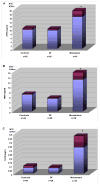Serum markers to detect metastatic uveal melanoma
- PMID: 17649791
- PMCID: PMC1986737
Serum markers to detect metastatic uveal melanoma
Abstract
Background: Osteopontin (OPN) is overexpressed in metastatic uveal melanoma (UM). S-100beta and melanoma-inhibitory activity (MIA) serum levels are elevated in metastatic cutaneous melanoma. The ability of OPN, S-100beta and MIA serum levels to be used as non-invasive markers for detecting metastatic UM was tested.
Patients and methods: OPN, S-100beta and MIA levels were measured by ELISA assays in 18 patients with metastatic UM and in 38 patients who were disease-free (DF) for at least 10 years after treatment of the primary tumor. Paired serum samples from 8 patients before and after development of metastasis were analyzed. Forty-four healthy controls (C) were compared to the other two groups.
Results: Serum OPN, MIA, and S-100beta levels were significantly higher in patients with metastatic UM as compared to patients who were DF for at least 10 years after treatment (p = 0.0001) or with age-matched controls. Serum OPN, MIA and S-100beta levels were significantly higher (p < 0.005) after metastasis formation than before the clinical detection of metastasis in the 8 patients. Receiver operator characteristic analysis was performed for metastatic patients vs. DF and vs. C, and the area under the curve was calculated for each marker and for the combination of the 3 markers, which was 91%.
Conclusion: Elevated serum OPN, MIA and S-100beta levels correlate with metastatic UM to the liver. When used in combination, these markers provide a highly sensitive and specific method to detect hepatic metastases and therefore provide for earlier therapeutic intervention that can prolong survival.
Figures




References
-
- Damato B. Developments in the management of uveal melanoma. Clinical and Experimental Ophthalmology. 2004;32:639–647. - PubMed
-
- Mudhar HS, Parsons MA, Sisley K, Rundle P, Singh A, Rennie IG. A critical appraisal of the prognostic and predictive factors for uveal malignant melanoma. Histopathol. 2004;45:1–12. - PubMed
-
- Kaiserman I, Amer R, Pe’er J. Liver function tests in metastatic uveal melanoma. Am J Ophthalmol. 2004;137(2):236–43. - PubMed
-
- Toivonen P, Makitie T, Kujala E, Kivela T. Microcirculation and tumor-infiltrating macrophages in choroidal and ciliary body melanoma and corresponding metastases. Investigative Ophthalmology and Visual Science. 2004;45:1–6. - PubMed
-
- Hannsson L, Hauschild A, Bonfrer JMG, Duffy J, Einarsson R. Tumor markers in malignant melanoma – EGTM (European Group on Tumor Markers) Guidelines. Tumor Biol. 2006;27:35 – S1.
Publication types
MeSH terms
Substances
Grants and funding
LinkOut - more resources
Full Text Sources
Medical
Research Materials
Miscellaneous
